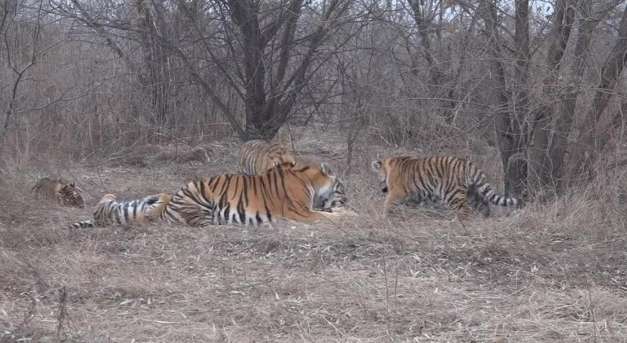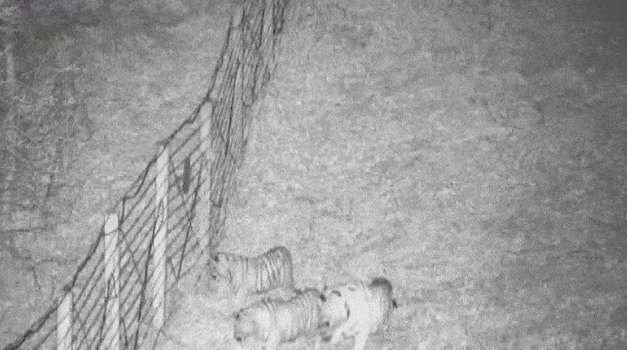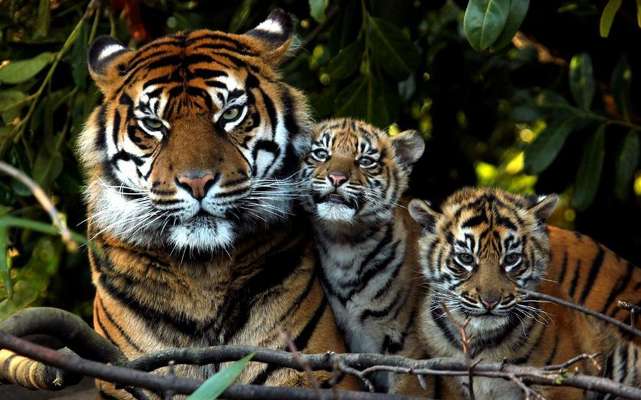People can intuitively feel that the number of Siberian tigers has increased in recent years. In fact, historically our country has also been a "big tiger country". Not only does it rank first in the world in terms of the number of subspecies, but the number of wild individuals is also very large.
However, after the 1950s, due to many reasons such as excessive hunting and habitat loss, the number of tigers in our country dropped sharply.
The South China tiger, which once had a wide distribution range and the largest number, has even disappeared from the wild. Now the Siberian tiger has become the most important wild tiger species in our country. The number is not large, there were only 35 in 2017, and now it has increased to more than 60.

For people in Hunchun, Jilin and other areas It is said that spotting tigers is nothing new. Every year, people encounter "blocking tigers" while driving, and under some surveillance systems, tiger shadows occasionally appear.
Recently, a surveillance camera captured a Siberian tiger in Banshi Town, Hunchun City. There are a total of 5 Siberian tigers walking before and after the picture. Four of them are petite and one is huge, so it is obvious that this is a family of Siberian tigers.
The mother tiger took four cubs out to look for food at night. They stopped and wandered, and behaved very cautiously. Judging from the situation photographed, this should be a teaching site for the tigress. During the nurturing period of the tiger cubs, after the cubs have the ability to go out and move around, the tigress will continue to teach them various survival skills.
Two babies are common, four babies are uncommon
The Siberian tiger is a typical mountain forest animal. It usually lives in dense forests and moves alone. It is only during the breeding season that they pair up. Male and female only live together briefly.
Many people say that male tigers are extremely irresponsible. They leave after the female tiger is pregnant and do not participate in the subsequent raising process. In fact, people have misunderstood it. It is not that the male tiger left on his own initiative, but that after the female tiger is pregnant, its attitude will change 180 degrees. From the previous ambiguity, it will become sensitive and irritable. Is it right? The male tiger loses his temper.

At this time, the male tiger also becomes more knowledgeable. He finds a dusk and chooses to leave silently and fall into the arms of another female tiger in heat in the territory.
The pregnancy period of the Siberian tiger is about 105 days. In the early stage of pregnancy, the female tiger barely shows her belly and still maintains a high ability to move. It is not until the later stages of pregnancy that her belly gradually swells and appears pregnant. However, this The tigress at that time still had the ability to hunt.
Only in the last 3-5 days before the cubs are born will the female tiger temporarily lose her hunting ability. But at this time, the tigress's first job is to find a safe and hidden place to give birth to her cubs.
Theoretically, a female tiger can give birth to 1-5 cubs per litter, usually 2. A tigress like this one that appeared in Banshi Town, Hunchun City, gave birth to four tiger cubs in one litter, which is rare in the natural environment.
The cub-rearing mechanism of the Siberian tiger
Tiger is a highly solitary cat. Male tigers hardly participate in the entire cub-rearing process. Therefore, after the mother tiger gives birth, the cubs are almost all I'm leading it myself.
Amur tigers originally had no fixed dens. However, during pregnancy and throughout the period of raising cubs, the female tiger will find several dens and live a semi-settled life.
Newborn tiger cubs are very fragile and highly dependent on the mother tiger. Therefore, at this stage, the mother tiger will improve her work efficiency, her hunting strategy will be more aggressive, and she will be more willing to try to kill larger and larger tiger cubs. It is a more difficult prey, so it is not unreasonable to say that the tigress is more ferocious.
Tiger cubs are not capable of going out until they are two months old. At this time, they will eagerly follow the mother tiger out in search of food.
At this time, the tigress also realized that the child was slowly growing up, so in the next few months, the tigress would learn various survival skills she learned from her mother. Teach to the little tiger. The cubs will practice and improve the hunting and fighting skills learned from the mother tiger through imitation and daily play and fights.

About one and a half years old, the little tiger Then he has the ability to live alone, but at this time, the cub is not eager to leave the mother tiger, but continues to live with the mother tiger for a while.
The male tiger stays away, and the female tiger makes a home nearby
In every tiger cub, there will be a stronger individual, which is called the "dominant individual". As the name suggests, "advantage individuals" are those who have the best performance in terms of vocalization and physical fitness.This little tiger is always ahead of its siblings.
The "dominant individual" is usually a small male tiger, and some are small female tigers. They will get all the resources of the female tiger, especially in some extreme situations, even life and death. choice.
For example, when food is scarce, the tigress will give priority to feeding the "dominant individuals". When food is extremely scarce, the tigress will even kill other tiger cubs, leaving only the "dominant individuals" . The reason is simple, because compared to other tiger cubs, the "advantage individual" has a greater chance of surviving in a harsh environment.
Almost every animal has its own mechanism to prevent inbreeding. The way tigers prevent backcrossing is to allow male tigers to establish their own territory as far away from their birthplace as possible.
One cub has the ability to survive independently, and after leaving the mother tiger, the young female tiger will establish its own territory around the mother tiger's territory, while the young male tiger will first move around the mother tiger. When the body becomes stronger and has more survival experience, it will stay away from the tigress and establish its own territory in the distance. Under normal circumstances, a male tiger's territory will contain the territories of 2-5 female tigers.
The Siberian tiger is the top predator in the forest ecosystem and a keystone species, which is crucial to maintaining the integrity of the forest ecosystem. They prey on medium and large ungulates and some carnivores, control the population development of prey, and maintain the balance between herbivores and vegetation in their environment.
The Siberian tiger is a first-level protected animal in my country. Although the number is rare, I believe that as the results of ecological construction and animal protection gradually become apparent, their number will gradually increase.